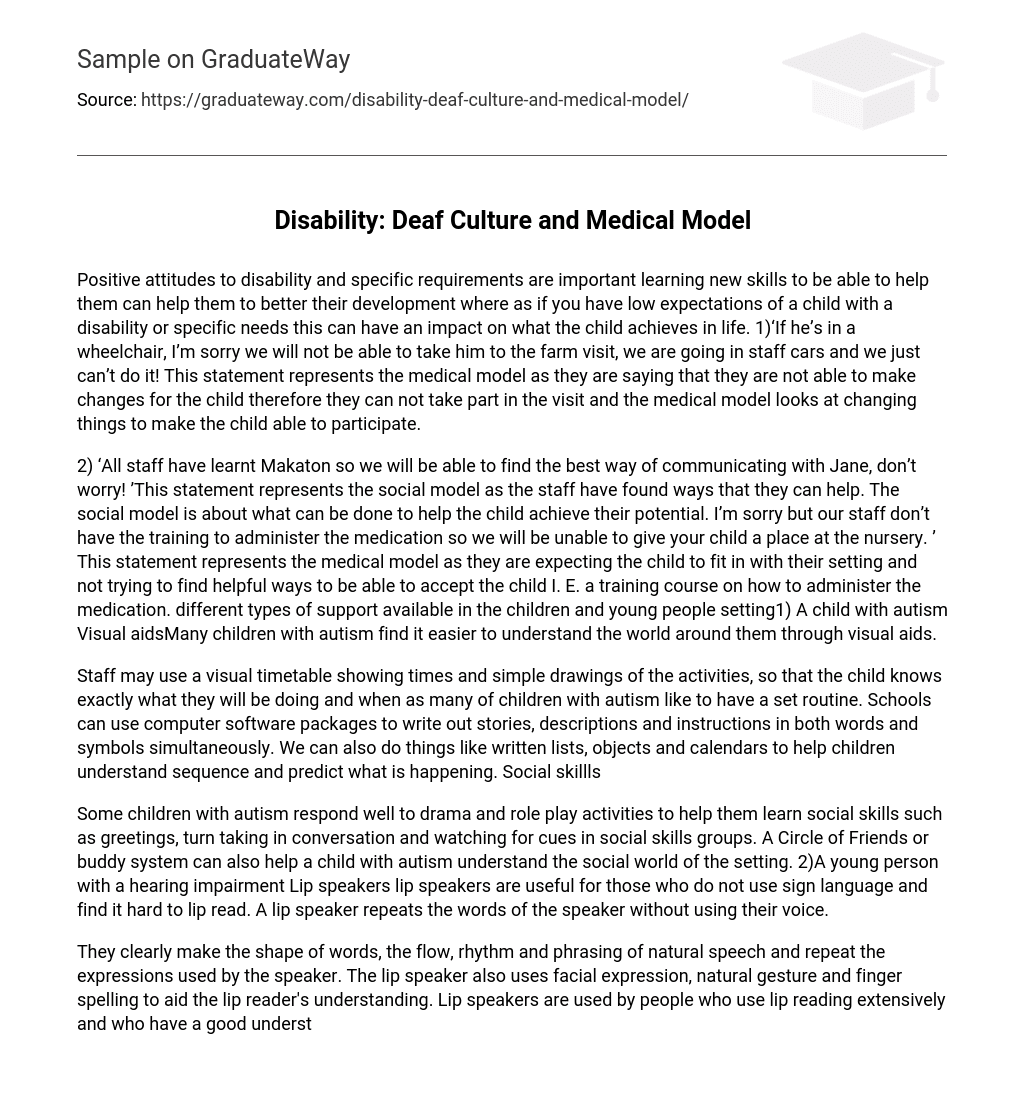Positive attitudes to disability and specific requirements are important learning new skills to be able to help them can help them to better their development where as if you have low expectations of a child with a disability or specific needs this can have an impact on what the child achieves in life. 1)‘If he’s in a wheelchair, I’m sorry we will not be able to take him to the farm visit, we are going in staff cars and we just can’t do it! This statement represents the medical model as they are saying that they are not able to make changes for the child therefore they can not take part in the visit and the medical model looks at changing things to make the child able to participate.
2) ‘All staff have learnt Makaton so we will be able to find the best way of communicating with Jane, don’t worry! ’This statement represents the social model as the staff have found ways that they can help. The social model is about what can be done to help the child achieve their potential. I’m sorry but our staff don’t have the training to administer the medication so we will be unable to give your child a place at the nursery. ’ This statement represents the medical model as they are expecting the child to fit in with their setting and not trying to find helpful ways to be able to accept the child I. E. a training course on how to administer the medication. different types of support available in the children and young people setting1) A child with autism Visual aidsMany children with autism find it easier to understand the world around them through visual aids.
Staff may use a visual timetable showing times and simple drawings of the activities, so that the child knows exactly what they will be doing and when as many of children with autism like to have a set routine. Schools can use computer software packages to write out stories, descriptions and instructions in both words and symbols simultaneously. We can also do things like written lists, objects and calendars to help children understand sequence and predict what is happening. Social skillls
Some children with autism respond well to drama and role play activities to help them learn social skills such as greetings, turn taking in conversation and watching for cues in social skills groups. A Circle of Friends or buddy system can also help a child with autism understand the social world of the setting. 2)A young person with a hearing impairment Lip speakers lip speakers are useful for those who do not use sign language and find it hard to lip read. A lip speaker repeats the words of the speaker without using their voice.
They clearly make the shape of words, the flow, rhythm and phrasing of natural speech and repeat the expressions used by the speaker. The lip speaker also uses facial expression, natural gesture and finger spelling to aid the lip reader’s understanding. Lip speakers are used by people who use lip reading extensively and who have a good understanding of the English language. Interpreters interpreters prefer to communicate through British Sign Language (BSL) or Sign Supported English.
The interpreter will translate what is said into sign and will provide a voice over. It is helpful to employ an interpreter who has some knowledge of the subject matter for a child (if they are in a lecture). 3) A child or young person who is visually impaired Braille Braille is a system of dots read by touch this help visually impaired children to learn to read and write books and note etc. Braille is implemented into classrooms through Braille books, cassettes and high tech computer devices, allowing students to type using Braille keyboards.
The code offers a suitable alternative to voice synthesizers and audiotapes in helping visually-impaired students learn to read. Video AidsVideo-magnifiers magnify text or video for visually-impaired students so they can more easily see classroom blackboards and projections. Many magnifiers can magnify images up to 75 times in either full colour or black and white. They can be easily linked to computers through USB connections and are standard in many classrooms.





